Roraima-hegy
«
vissza a Terebess Online nyitólapjára
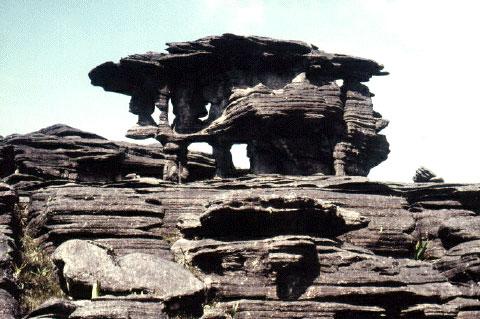
Roraima-tepui
A Roraima-hegy hatalmas, mintegy 15 km hosszú, lapos tetejű, 2772 m magas hegy a Pakaraima-hegységben, Brazília, Venezuela és Guyana határának találkozásánál. Innen ered Guyanának, valamint az Amazonas és az Orinoco vízrendszerének több folyója.
In the south-eastern corner of Venezuela, and also overlapping into parts of Brazil and Guyana, is the geological formation known as the Roraima Group. These sedimentary rocks, up to 3,000m deep, were laid down over 2 billion years ago as the ancient continent of Pangea was eroded by thousands of years of incessant rain, and remained unsubmerged as Gondwanaland was split apart under the forces of Continental Drift to form Africa and the South America. It is sobering to think that when the first plant life appeared these rocks were already at least 1.4 billion years old. The present-day tepuis, a Pemón Indian word for mountain, are believed to be remnants of the gigantic sandstone plateau which was selectively eroded after movements in the Earth's crust caused points of weakness which were exploited by the great rivers of the region. Today the table mountains tower above the surrounding savanna, often with sheer cliffs of thousands of feet.
The first European to describe the tepuis was Sir Walter Ralegh, who explored the area to the north in 1595, and was taken by the local Indians to within sight of a mountain of 'Christall':
'...it appeared like a white Church towre of an exceeding height: There falleth ouer it a mightie riuer which toucheth no parte of the side of the mountaine, but rusheth ouer the toppe of it, and falleth to the grounde with a terrible noyse and clamor, as if 1000 greate belles were knockt one against another.'
Ralegh was widely disbelieved, as he asserted that this mountain marked the way to the legendary city of El Dorado, and it was not until Robert Schomburgk's travels during the 19th century that the tepui's existence was confirmed.
The
highest tepui in the Venezuelan Gran Sabana is Roraima, 2,810 metres, on the border
with Brazil and Guyana. The name is a Pemón Indian word meaning 'The large and
ever-fruitful Mother of the streams'. Its 44 square mile plateau was first climbed
by the English botanist Everard Im Thurn on an expedition sponsored by the Royal
Geographical Society in 1884, and it was his subsequent lectures in England, together
with those of Colonel P H Fawcett on the Serra Ricardo Franco range in Brazil,
that are believed to have been the inspiration for Sir Arthur Conan Doyle's 'The
Lost World': http://etext.lib.virginia.edu/toc/modeng/public/DoyLost.html
http://onlinebooks.library.upenn.edu/webbin/gutbook/lookup?num=139
Sir Arthur Conan Doyle: Az elveszett világ (rtf)
http://www.rpg.hu/iras/mutat.php?cid=3090
Everard Im Thurn botanikus az 1880-as évek végén Londonban rendszeresen tartott előadásokat a dél-amerikai kutatóútjáról. Hírnevét többek között annak köszönhette, hogy ő jutott fel elsőként a venezuelai Roraima táblahegy tetejére, ahol olyan növény- és rovarfajokat talált, amelyek évmilliók óta a világtól elszigetelten fejlődtek, s alkalmazkodtak a különleges életkörülményekhez.
A hallgatóság egyik tagját annyira lenyűgözte a beszámoló, hogy képzeletében a broméliákon, és az orchideákon kívül dinoszauruszokkal és emberszabású lényekkel is benépesítette a fennsíkot. Mivel történetesen egy népszerű íróemberről volt szó, nem sokkal később már nyomtatásban is megjelent „Az elveszett világ”.
A kölcsönhatás elvének köszönhetően (no meg a regény sikerének) a Gran Sabana mintegy félmillió négyzetkilométeres térségét azóta úgy emlegetik, hogy El Mundo Perdido, azaz az Elveszett világ.Sir Arthur Conan Doyle (Sherlock Holmes figurájának megalkotója) számos detektívtörténeten, történelmi- és kalandregényen, misztikus és fantasztikus histórián kívül ezzel a kisregénnyel ismét olyan történet tálalt az olvasóknak, amelyet nyugodt lélekkel mondhatunk alapműnek, s mint ilyet az idők során nem győzték feldolgozni, mozgóképre álmodni.
A siker azért is furcsa, mert a kisregény terjedelménél fogva - napjaink átlagos terjedelmű könyveihez mérten - némileg szűkszavú. Ráadásul a történet kidolgozottsága nem is tekinthető egységesnek, hiszen a bevezetés és a fennsíkon játszódó kalandok teszik ki a terjedelem 94 %-át, csupán a fennmaradó 6% tartalmazza a menekülés, a hazajutás és az otthoni fogadtatás „viszontagságait”.Alapmű lévén ezúttal mellőzöm a cselekmény részletes ismertetését, a lényeg az, hogy egy beképzelt tudós (Challanger professzor), egy szobatudós (Summerlee professzor), egy újságíró (Dunn Malone Edward) és egy neves vadászként ismert lord (Lord John Roxton) tudományos expedícióra indul, melynek célja az elveszett világ felkutatása. Számos kaland után eljutnak a felhők feletti fennsíkra, ahol az őskori növények és állatok között kislétszámú a fejlettség különböző fokán lévő ősemberkolóniák éldegélnek csendes elszigeteltségben.
While no giant dinosaurs have (yet!) been found, the summit's of the tepuis, isolated for millions of years, are a fascinating place to study the evolution of plants. Of the 2,000 species that have been found, a staggering 50% are endemic to this region, and many are only found on one peak. The clouds that almost permanently engulf the summits have led to them being called a 'rain desert', as the washing action of the rain coupled with high levels of radiation from the sun mean that plants have had to develop unusual mechanisms to survive. This is the only place, for example, where carnivorous bromeliads have been found. It is also one of the few remaining places on earth where 100% of the species are native (compare the British Isles where 30% have been introduced), offering unrivalled opportunities for study. Today the most serious threat comes from the interference of Man, and particularly as Roraima is one of the few peaks that are scaleable without specialist equipment, we must all be aware of the genetic treasure that it is our responsibility to protect.
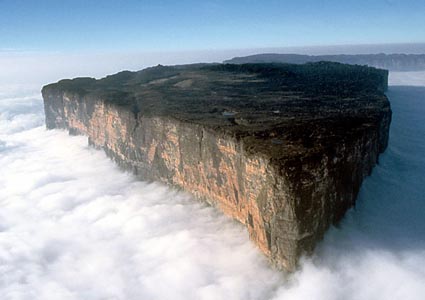
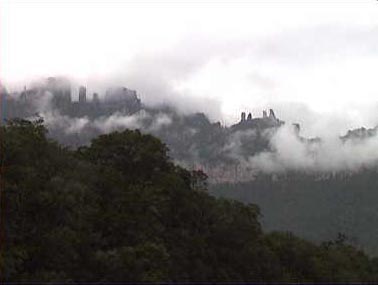
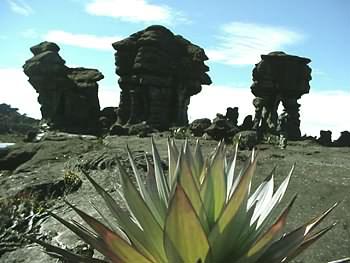
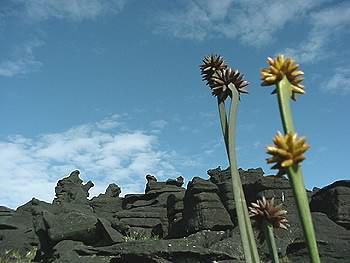
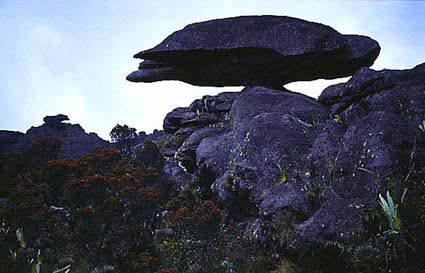
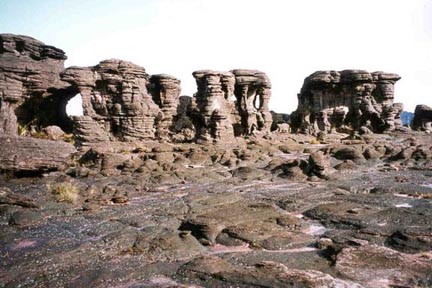
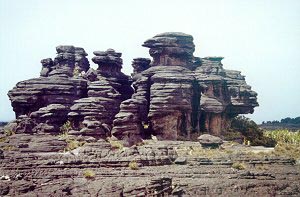
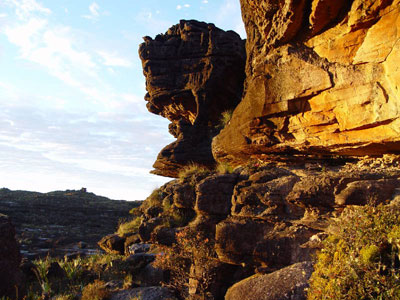
http://www.boavista.rr.gov.br/imagens/Monte%20Roraima.jpg
Pedra
Pintada, Roraima: http://www.gobrasil.net/images/roraima-400.jpg
http://perso.wanadoo.fr/yann.michel/ve_roraima8_grand.JPG
http://www.ual.es/~jlguil/Investigacion/roraima.jpg
http://home.wxs.nl/~bange006/natparks/roraima.jpg
http://www.amazonair.com/Roraima/Images/40a.jpg
http://perso.wanadoo.fr/yann.michel/ve_fcarnivore_grand.JPG
http://de.wikipedia.org/wiki/Bild:Roraima-Tepui_Wand.jpg
http://de.wikipedia.org/wiki/Bild:Roraima-Tepui_Plateau.jpg
http://de.wikipedia.org/wiki/Bild:Kukenam-Tepui.jpg
http://blog.sme.sk/blog/299/2670/Roraima%20summit001.jpg
http://www.hory.applet.cz/venezuela/ven_ror1_e.html
http://www.fulldayturismo.com/roraima/images/ror1.jpg
http://www.lastrefuge.co.uk/data/articles/tepuis/tepuis_Main_Journey.html